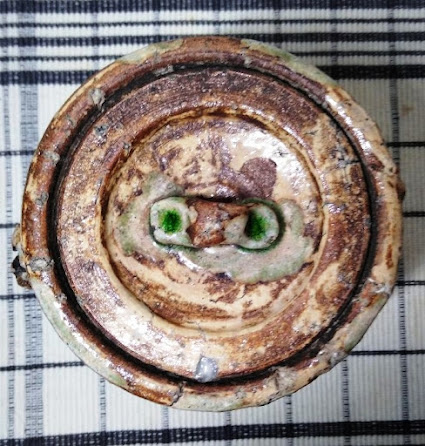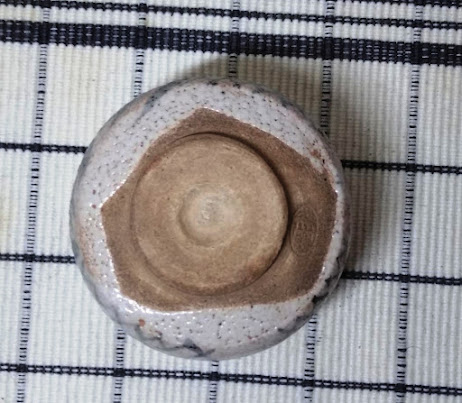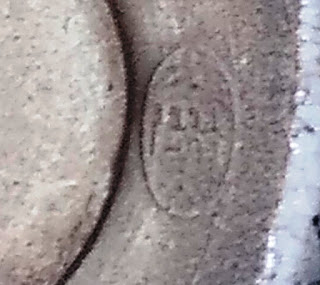219. FURUTANI Taketoshi 古谷剛敏, 1974- , Shigaraki shizenyū hanaire 信楽自然釉花入 (Shigaraki vase with natural ash glazing)

Furutani Taketoshi is the son of Furutani Hirofumi 博文 (Chūroku 忠六 II) and grandson of Furutani Hiromu 弘 (Chūroku I), all potters in the Shigaraki tradition.
Gray clay, with natural ash glazing, with colors in the tan, brown, and black ranges, with vitrified green glass-like glaze in the depressed area on the top where the ash pooled. Weight: 1.5 kg (3.4 lb). Height: overall 15.2 cm (6 in); of walls 12.6 cm (5 in). Width: mouth 2.7 cm (1-1/.8 in); rim 5.1 cm (2 in); walls at top 11.8 cm (4-5/8 in); widest 12.6 cm (5 in); base 11.3 cm (4-1/2 in).
This sits on the flat base, which is roughly circular with many indents in the circumference. The base has been scored with a flat spatula-like tool to create wide planes with ridged edges. The surface of the base is puckered with many small indentations. The artist’s mark was etched into the center of the base. There are the remains of the three wedges used to separate the pot from the shelf during firing and a small paper sticker with 83 written on it (from the June 2023 exhibition of the Furutanis’ wares at the Kura Monzen Gallery in Kyoto). Above the base is a convex bulge extending to a height of about 4 to 4.5 cm (1-1/2 to 1/3/4 in). There are several horizontal grooves in this area. Above this the walls rise in more or less a straight line. The upper edge of the walls is jagged and broken and quite thin at the top edge. It surrounds a flat, level depression about 1.2 cm (1/2 in) deep surrounding the central neck and opening of the vase. The neck is 3.7 cm (1-1/2 in) tall. It is narrowest at the base and flares outward at a steep angle to the rim. The rim is flat, roughly oval in shape and of varying widths. The surface of this is glassy smooth where the vitrified ash deposits were thickest and rough where the surface absorbed fly ash without vitrification. The molding of this was (intentionally) very rough. The piece is bottom-heavy.
The glazing on this is entirely the result of natural ash deposits vitrifying in the kiln. With the exception of the base and a portion of the lower walls that must have been out of the reach of the flames, the surface is coated with a thick vitrified ash glaze. The depressed area at the top has a thick deposit of a dark green, glass-like melted ash glaze.
The piece came in a wooden box with an inscription by the artist. Included in the box was an orange wrapping cloth stamped in red with the artist’s seal and a printed sheet containing the artist’s biography. The characters on the box lid are (from right to left) 信楽 Shigaraki 自然釉 shizenyū (natural ash glaze) 花入 hanaire (vase) 剛敏 Taketoshi, followed by the artist’s seal stamped in red. The seller included a copy of the exhibition catalogue as well.
Purchased from the Kura Monzen Gallery, Kyoto, Japan, June 2023 (invoice, shipping and customs docusments; exhibition catalogue).


















































